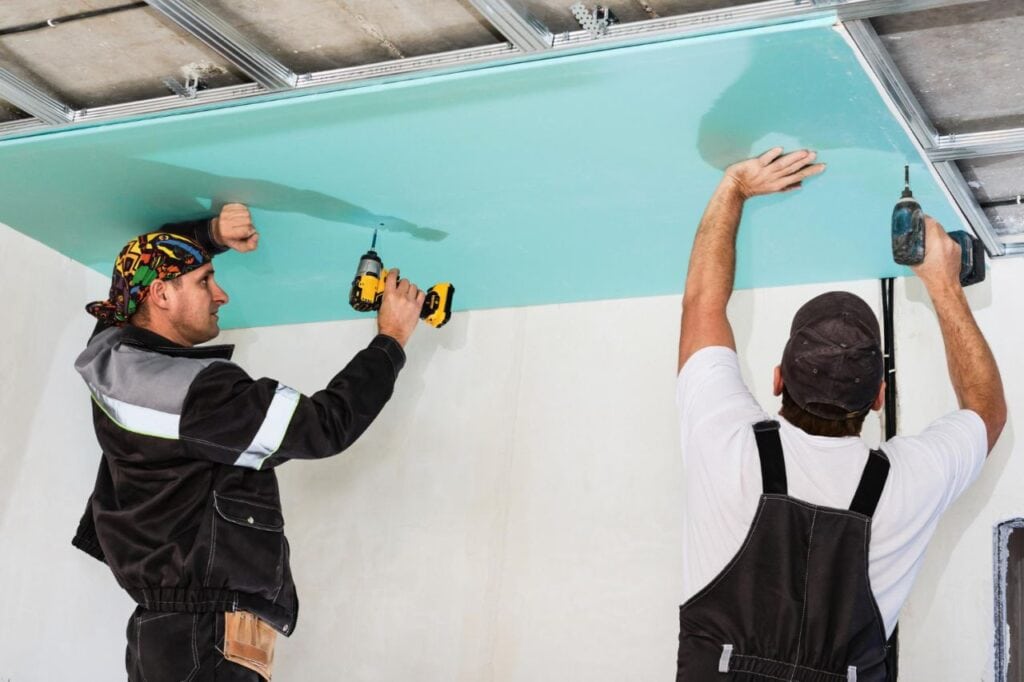Need a trustworthy plaster and ceiling repair contractor but need help deciding between all the available ones? Have no fear! In this post, we'll show you the ropes for finding a reliable contractor to fix your ceiling or plaster.
Finding the appropriate contractor is crucial whether you need to repair water damage, replace damaged ceilings, or improve the aesthetics of your home. So, how do you know you're picking the best option?
One of the most important things to consider when picking a plaster and ceiling restoration professional is their experience and reputation. Find a contractor with a track record of producing excellent results and keeping customers happy.
Ensure they have the appropriate licencing and certificates to prove they are serious about their work.
Enquire further about how they have dealt with projects that are similar to yours. You can relax knowing that your plaster and ceiling repairs are in good hands if you hire a professional with the right skills and experience.
But how can you choose the best contractor when so many compete for your business? In the main post, we'll go into greater detail on how to go about choosing a plaster and ceiling repair contractor, with advice from well-respected professionals in the field.
We'll discuss the importance of getting numerous estimates, checking references, and looking at previous work.
Following these guidelines, you can pick a contractor who exceeds your expectations. Without further ado, let's explore the realm of plaster and ceiling repair contractors so you can hire the most qualified professional for the job.
Hiring the correct plaster and ceiling restoration specialist is essential if you want flawless results and long-lasting repairs. Let's get you started on the right foot by examining the details of this procedure.
Keep an eye out for the future piece, and as you read it, feel free to comment with your observations and insights.
Before You Start Hiring A Plasterer
Do you wish someone would fix the walls that have holes and flaking paint? Do you long for the day when every surface in your home is faultless and smooth? If that's the case, you should look into getting a plasterer.
They have the skill to smooth out uneven surfaces and create beautiful works of art. They have the skills and eye for detail to fix any flaws in your walls so that they look brand new and beautiful.
However, these advantages are not automatic and require careful decision-making. The market is saturated with plasterers, making settling on the best one difficult. How can you tell if an applicant is trustworthy and competent?
In this in-depth essay, we'll walk you through the process of choosing a plasterer from start to finish.
Find A Qualified Plasterer
When did Plasterer first open its doors? A licenced or certified plasterer will always have a copy of their identification card or licence. Indemnity insurance is essential for plasterers in case of accidents on your property.
Check The Plasterer's Insurance And Public Liability
You can verify a contractor's registration with the appropriate trades board by requesting a copy of their public liability insurance certificate.
Get Three Job Quotes
If you need a plasterer, you should shop about and compare prices from at least three different professionals before making a final decision. It is highly recommended that you request references from the quote providers. You can then ask a third party with knowledge of their work's quality to contact them.
Look At A Plasterer's Work
How tidy and consistent is the result? Does the plasterer do a good job matching the existing plaster's colour and texture and finishing the corners? It's important to be neat when applying plaster. Examine every surface minutely to see if you can spot any flaws.
Start With A Quote
Get a formal estimate from your contractor to eliminate any guesswork about how much the job will cost. Before beginning any job, it is important to communicate clearly with your contractor by discussing the quotation in detail.
Hire A Reliable Plasterer
Don't put undue pressure on your plasterer to rush through the job so you can save money or time. Stresses like these might cause workers to rush through their tasks, leading to poor quality and, ultimately, unhappy customers.
You should steer clear of these kinds of contractor/client interactions. To determine if a plasterer is reliable, you can consider the following factors:
- Recommendations and referrals: Seek recommendations from friends, family, or colleagues who have recently had plastering work done.
- Online reviews and ratings: Check online platforms such as review websites, social media pages, or trade directories to read reviews and ratings from previous clients.
- Portfolio and experience: Ask the plasterer for a portfolio of their previous work.
- Communication and professionalism: Observe how the plasterer communicates with you during the initial contact.
- Written estimates and contracts: Request written estimates from multiple plasterers and compare them.
- References: Ask the plasterer for references from past clients.
Use Skilled Plasterers
Many plasterers cut corners once they've started working for you because they feel deceived about the price and lose enthusiasm for doing a good job. Usually, it's because they feel cheated out of something in the agreement.
Finding a plasterer willing to work within a reasonable pricing range would be very beneficial.
Plastering, however, is typically executed to a subpar level for most lesser works. Therefore, you spend more down the road to fix the poor quality job, or worse, something catastrophic could go wrong with your plaster, necessitating a full strip and rebuild.
Ensure your plasterer will not plaster over the existing plastering or cover up someone else’s mistakes. Also, check that your plasterer has the right equipment and uses decent quality screw guns that don’t have frayed leads and look like they fell out of a rubbish bin.
Finally, a good contractor will be well equipped with the right tools for the job, not ladders held together with tape and glue. There’s an old saying; you’re only as good as the tools you use.
Hire A Plasterer With The Right Personality
Hiring a contractor with excellent customer service skills and one who is pleasant, kind, and easygoing may make a huge difference in how you feel during the course of the project.
Plasterers that know what they're doing in terms of application, cost (no regrets on the quote), and customer relations tend to have positive experiences with their clientele.
Ask About The Plastering Process
Make sure you know how long each section of the contract will last so you can calculate how long they will be staying in your home. Ensure the plasterers won't cut corners using lower-quality plasterboard or incorrect finishing products to hide flaws.
As a client, your goal should be to have secure, satisfying work, so asking the right questions at the outset might prevent you from backtracking later.
What Are The Hiring Processes Of Plaster & Ceiling Contractors?

A few important measures are involved in finding reliable contractors to do plastering and ceiling work. It's important to start with solid groundwork in the form of research and advice from reliable people.
When you have a shortlist of possible contractors, it's time to ask for bids. Next, ensure they have all the necessary documentation, like licences, certifications, and insurance. You can now choose wisely considering the contractor's track record, reputation, and capacity to fulfil your unique requirements.
Plaster and ceiling contractors may go through various stages of the employment process before being chosen by a company. Nonetheless, here are some typical stages of an employment selection procedure:
Job Posting
The organisation develops a comprehensive job description for the plaster and ceiling contractor role, outlining its duties, desired skills, and other specifics.
This summary is distributed via traditional and unconventional channels, including social media, online job boards, and traditional media like newspapers and trade magazines.
Application Submission
Candidates respond to the job advertisement by submitting resumes and cover letters. A typical application consists of a cover letter, curriculum vitae, and any additional materials the employer requires.
These materials summarise the candidate's qualifications in terms of experience, expertise, training, and credentials.
Resume Screening
The recruiting group checks all the applications and resumes for potential candidates.
They seek individuals with the bare minimum of required skills and experience, including a background in plastering and ceiling work, familiarity with various plastering methods and materials, and relevant certificates and licences.
Phone Or Video Interviews
After an initial review of resumes, the hiring team will contact the top prospects to perform follow-up interviews by phone or video chat. Candidates' viability for the position will initially be evaluated through interviews.
During the interview process, candidates may be questioned about their past job history, specific areas of expertise, problem-solving capabilities, communication styles, and teamwork attitudes.
In-Person Interviews
Candidates who do well in the screening interviews may be asked to attend a face-to-face meeting. At this point, the recruiting team can observe the candidate in person and understand their demeanour, confidence, and social skills.
Hiring managers, project managers, and other pertinent employees may make up the interview panel. Candidates may be subjected to more in-depth enquiries about their experience, ability to handle difficult situations, and familiarity with safety procedures specific to plastering and ceiling work.
Skill Assessment
Candidates may be required to show their proficiency in practical situations to be hired, depending on the organisation's needs.
They may be requested to demonstrate their knowledge of plastering techniques on test surfaces, construct a small portion of the ceiling, or diagnose and repair typical problems associated with such work.
At this point, the recruiting staff may see how well each candidate performs on various plastering and ceiling work duties.
Background Check
A background check may be performed after an applicant has passed the initial steps of the hiring process. This is a crucial stage in establishing the candidate's credibility and ensuring the information they provided on their application is accurate.
Reference Check
Employers frequently contact the references they have provided to learn more about a candidate's work ethic, dependability, and teamwork skills. The candidate's references should include people knowledgeable about their work and character, such as former managers, coworkers, or clients.
Job Offer
A job offer is made if an applicant successfully completes each step of the hiring process and the company is pleased with their qualifications, skills, and general fit for the position.
Common information included in an offer is salary, benefits, start date, and expected length of employment. The candidate could be given time to consider the offer and negotiate the terms.
Onboarding
After an applicant accepts a job offer, they enter "onboarding." Training, familiarisation with corporate policies and processes, and completing any essential documentation (such as an employment contract or tax forms) may all be part of this process.
They may also be introduced to other team members, given a mentor, or given access to resources to help them adjust to their new position.
Conclusion
Plastering a structure to make it waterproof is a common practise in the construction industry. After the surface is ready, an additive is incorporated into the plaster or rendering mixture to obtain the desired effect.
Plaster is put in thin layers until the desired thickness is reached and a smooth, even finish is produced. It finds widespread application in moist areas like cellars, bathrooms, swimming pools, and external walls.
The protection it provides against water, moisture, and mould growth helps to make the structure more robust and durable.
Plastering that is both waterproof and damp proof entails the installation of a barrier to prevent water from penetrating the surface. If you want to make sure your waterproof plastering project turns out well, consulting with professionals is a must.
Gore-Tex, polyvinyl chloride, natural materials, silicone, and bituminous membrane are all great options for waterproofing. Gore-Tex is a waterproof, windproof, and breathable material.
Pipes and other plumbing fixtures often make use of polyvinyl chloride (PVC), a synthetic material that is both waterproof and durable.
Beeswax, oiled leather, and waxed canvas are all examples of natural materials. Silicone is a sealant and protective coating that is both versatile and long-lasting.
Waterproofing with a bituminous membrane works well on low-slope or flat roofs. Torching bitumen onto a membrane is the earliest way of waterproofing a structure.
The newest development is a self-adhering bitumen and membrane that has the ability to stretch by 150%.
Waterproofing a concrete slab with a bituminous coating is the best option, whereas cementitious coatings are more common in humid interior spaces.
When applied over a topcoat, liquid waterproofing membrane can increase its durability by as much as 280%. Waterproofing a structure can improve its safety, longevity, and occupant satisfaction.
Materials used for waterproofing have many benefits, including their ability to keep the interior of a building at a reasonable temperature, their adaptability, and their low environmental impact. Finding leaks in the waterproofing before they cause major problems or expensive repairs is crucial.
Leaks, fungus, and structural degradation are all warning signs.
Mould and mildew can create expensive structural damage and health problems, and water leaks are a telltale sign of trouble. If mould starts to grow, it's time to investigate the source of moisture and address any waterproofing problems.

Look for signs of peeling paint, bubbling wallpaper, eroding plaster, efflorescence, cracks, buckling, or warping; excessive moisture; pest infestation; soaring utility costs; missing or broken tiles; and deteriorating caulking around windows and doors. If any of these red flags appear, it may be time to look into the waterproofing.
Content Summary
- Importance of finding a trustworthy and reliable contractor.
- Consider the contractor's experience and reputation.
- Ensure the contractor has the necessary licensing and certificates.
- Enquire about their past projects similar to yours.
- The challenge of choosing the best contractor from many options.
- Importance of getting numerous estimates and checking references.
- Look at previous work to assess the quality and consistency.
- Obtain a formal estimate to eliminate the guesswork in cost.
- Avoid pressuring the plasterer to rush through the job.
- Seek recommendations and referrals from friends or family.
- Check online reviews and ratings of the plasterer.
- Request a portfolio of the plasterer's previous work.
- Evaluate the plasterer's communication and professionalism.
- Ask for written estimates and contracts for comparison.
- Inquire about the plasterer's references from past clients.
- Choose skilled plasterers who don't cut corners.
- Ensure the plasterer doesn't plaster over existing flaws.
- Check the quality of the plasterer's equipment.
- Importance of hiring a plasterer with a pleasant personality.
- Understand the duration of the contract and materials used.
- Hiring processes of plaster and ceiling contractors.
- Creation of a job description and advertising the role.
- Submission of applications, resumes, and cover letters.
- Screening resumes based on skills and experience.
- Conducting phone or video interviews with top candidates.
- Arranging in-person interviews with potential hires.
- Assessing candidates' skills in practical situations.
- Performing background checks on selected applicants.
- Contacting references to validate the candidate's qualifications.
FAQs About Plaster Repair
The timeframe for hiring a ceiling repair contractor depends on the urgency of the repairs and the availability of contractors in your area. It's recommended to start the process as soon as possible to ensure you have enough time to research, obtain multiple quotes, and schedule the repairs. Keep in mind that contractors' availability may vary, so early planning can help you secure a reliable contractor within your desired timeframe.
The duration of a ceiling repair project depends on the extent of damage and the complexity of repairs required. Minor repairs, such as fixing small cracks or patching holes, can be completed in a few hours or days. However, more extensive repairs, such as water damage restoration or structural repairs, may take several days or even weeks to complete. It's best to discuss the timeline with your chosen contractor before the project begins to manage your expectations.
Ceiling repair contractors handle various types of repairs, including but not limited to:
- Fixing water damage: This involves repairing ceiling stains, leaks, or structural damage caused by water intrusion.
- Cracks and holes: Contractors can patch and repair cracks, holes, or dents in the ceiling.
- Popcorn ceiling removal: If you want to remove a popcorn ceiling, contractors can safely and efficiently handle the removal process.
- Ceiling texture repairs: They can match and repair different types of ceiling textures, such as knockdown, orange peel, or smooth finishes.
- Structural repairs: In cases where the ceiling has structural issues or sagging, contractors can reinforce or replace damaged components.
If we look at the ceiling fixer salary statistics in Australia as of 7 June 2023, the represented employee makes $83,600; to be more precise, the pay rate is $6,967 per month, $1,608 per week, or $44 per hour.
And repairing a ceiling after someone has fallen through it costs between $250 and $750. More expensive repair types include sagging, with a price range between $250 and $1,000. Water damage costs $200 and $1,500 to repair, while repairing a leak and a damaged ceiling can be as much as $2,000.

